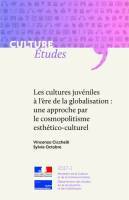Vincenzo CICCHELLI, Sylvie OCTOBRE
February 2017
20 p.
Art works and cultural products are circulating all over the globe at an increasing rate, helping to form young people’s ever-more internationalised tastes and repertoires. Hence the TV series Game of Thrones, which broke all audience records, the 2010 South African football anthem Waka Waqua as interpreted by US-chart-smashing Colombian singer Shakira, and even the Japanese manga character Naruto have become shared cultural references amongst young French people today, alongside national icons such as Astérix and David Guetta.
Manga, comics, Asian films, Hollywood blockbusters, Bollywood cinema, South Korean and Scandinavian TV series and music from all corners of the globe all function as windows on the world, helping make the foreign familiar. Whether in the areas of pop music, video games, television series, literature or cinema, the globalisation of the cultural industries and the ncreasing circulation of art works and cultural products, assisted by digital technology, are therefore major factors in the internationalisation of young people’s consumer and imaginative cultural repertoires.
How do young people build their relationship with the world via globalised cultural goods? Five configurations of aesthetico-cultural cosmopolitanism have been identified on the basis of the degree of internationalization of consumption and tastes, linguistic choices (French or foreign anguage), as well as global imaginaries and related values. These range from inadvertent cosmopolitanism related to the consumption of mainstream cultural products, to more engaged forms of openness (cosmopolitan fans and specific cosmopolitans), and to national cultural fans as well as impossible cosmopolitans. Young people’s cultural consumption brings them resources and competencies and helps them forge varied relationships to the globalized world in which cosmopolitanism is becoming a highly inclusive generational standart of “good taste”.


